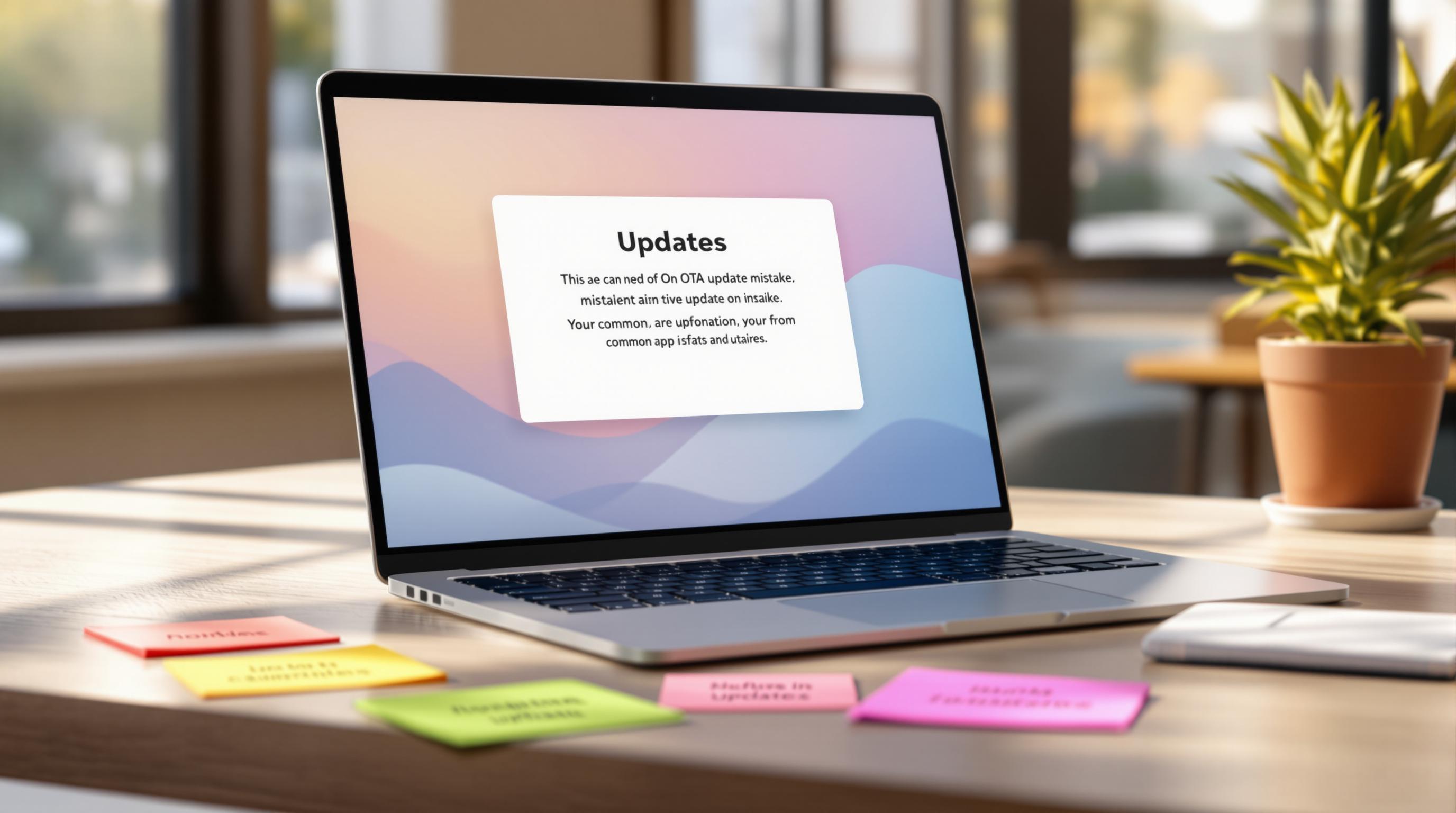App Store updates or direct OTA updates? The way you deliver app updates can significantly impact speed, control, and user experience. Here’s a quick breakdown:
-
App Store Updates: Go through a review process, ensuring security and compliance but often delayed by hours or days. Ideal for global rollouts but limits flexibility.
-
Direct OTA Updates: Skip app store reviews, enabling faster updates for UI tweaks or bug fixes. Best for rapid changes and targeted updates but requires developers to manage security and compliance.
Quick Comparison
| Aspect | App Store Updates | Direct OTA Updates |
|---|---|---|
| Speed | Days to weeks | Minutes to hours |
| Control | Limited by app store rules | Fully managed by developers |
| Use Cases | Global rollouts | Targeted, rapid fixes |
| Security | Handled by app stores | Developer-managed |
| Cost | 15% commission on transactions | No platform fees |
Key takeaway: Use App Store updates for reliability and compliance, and direct OTA updates for speed and flexibility. Choose based on your app’s needs and user expectations.
Ionic & Capacitor for Building Native Mobile Apps
App Store Updates Explained
App Store updates are the go-to method for delivering software updates through official platform marketplaces. This system is the main distribution channel for most mobile apps, with specific steps and guidelines developers must follow.
How App Store Updates Work
Submitting an update to the App Store means preparing a package that meets Apple’s requirements and passing a review process. Apple checks updates for security, performance, content guidelines, and functionality. Using App Store Connect, developers submit their updates, which undergo thorough evaluation, including testing on supported devices, security checks, and compliance reviews.
Benefits of App Store Updates
The App Store makes app distribution and maintenance easier. It handles tasks like update delivery, security checks, notifying users, and even payment processing. This centralized system ensures a consistent experience for users and builds trust in the platform.
Drawbacks of App Store Updates
While convenient, the App Store system comes with some notable downsides for developers:
| Challenge | Effect on Developers |
|---|---|
| Review Delays | Updates may take days to go live, slowing down critical fixes |
| Limited Control | Developers depend on Apple’s schedule for urgent releases |
Other issues include Apple’s 15% commission on transactions [1] and restrictions from sandboxing requirements [2], which can limit development flexibility and affect business strategies.
Because of these hurdles, many developers are turning to alternatives like OTA (over-the-air) updates. While the App Store offers a secure and centralized system, exploring faster, more adaptable options can be a game changer for many teams.
Direct OTA Updates with Capacitor
Direct over-the-air (OTA) updates let developers bypass app store review delays, making it easier to release new features and fixes quickly. This approach changes how updates are delivered to users’ devices.
What Are Direct OTA Updates?
With direct OTA updates, developers can push changes to JavaScript, HTML, and CSS without needing to submit a new app version to the app stores. Using Capacitor, these updates can be sent straight to users’ devices, simplifying the entire update process.
Why Use Direct OTA Updates?
| Advantage | Explanation |
|---|---|
| Faster Updates | Changes reach users immediately, skipping the time-consuming app store reviews. |
| Cost Savings | Avoids recurring submission fees for app updates. |
| Seamless for Users | Updates happen in the background without requiring user action. |
| More Control | Lets developers test features with specific user groups. |
These benefits make OTA updates an attractive option for teams focused on speed and adaptability. Tools like Capgo add extra layers of security with encryption and integrate with CI/CD pipelines for smooth, secure updates.
Staying Compliant and Managing Risks
When using OTA updates, it’s essential to follow platform-specific guidelines:
-
Content Changes: OTA updates are generally fine for UI tweaks, content updates, or small functionality adjustments.
-
Native Code: Any changes to native code must still go through the app store review process.
-
Platform Policies: Updates must use secure delivery mechanisms to comply with platform rules.
Platforms such as Capgo include features like version control and rollback options, ensuring updates are both safe and compliant. These safeguards help developers avoid risks while taking advantage of the flexibility OTA updates provide.
That said, developers should carefully weigh the speed and convenience of OTA updates against the thoroughness and structure of app store updates to decide what works best for their app.
sbb-itb-f9944d2
Comparing App Store and Direct OTA Updates
Differences and Use Cases
Deciding between App Store and OTA updates directly impacts how you deploy your app. App Store updates are known for their reliability and ease of use, while OTA updates excel in speed and adaptability, making them ideal for enterprise apps.
For enterprise or internal apps, direct OTA updates bring clear benefits. They allow for quicker iterations and adjustments without waiting for app store reviews.
When working on cross-platform apps, your update strategy becomes even more important. Enterprise developers often turn to direct OTA updates for situations like:
-
Rapid fixes without app store delays
-
Fast feature rollouts for urgent needs
-
Customizable update schedules tailored to organizational goals
-
Fine-tuned control over which users get updates
The table below breaks down the key differences between these two update methods.
Comparison Table
| Aspect | App Store Updates | Direct OTA Updates |
|---|---|---|
| Distribution Control | Managed by app stores | Handled by developers |
| Update Speed | Takes days to weeks | Happens in minutes to hours |
| Feature Flexibility | Restricted by sandboxing | Allows complete feature access |
| Revenue Impact | 15% cut to Apple | No platform fees involved |
| Security Management | Managed by the platform | Developer takes responsibility |
| Deployment Scope | Global rollouts | Targeted distributions |
Capgo provides secure OTA updates with encryption and management tools designed for developers. For those handling enterprise apps, tools like Capgo offer:
-
Version control with rollback options
-
Real-time monitoring of updates
-
User-specific update targeting
-
Integration with CI/CD pipelines
Choosing the right update method depends entirely on your needs. As highlighted in the Apple Developer Forums:
“If you’re delivering a macOS app outside the Mac App Store, you have to provide the update functionality yourself” [3].
Integrating OTA Updates into CI/CD Pipelines
For developers considering direct OTA updates, weaving these updates into CI/CD workflows can help you take full advantage of their speed and flexibility.
Using Tools Like Capgo

Delivering updates quickly and efficiently is a must for modern development teams. Tools like Capgo simplify this by offering features like version control, analytics, and staged rollouts. These capabilities make it easier to manage OTA updates, especially for enterprise teams that deal with large-scale deployments. User targeting and flexible deployment options further enhance the process.
By incorporating tools like Capgo, you can fine-tune your CI/CD pipeline to deliver OTA updates efficiently and reliably.
CI/CD Integration Tips
Integrating OTA updates successfully means balancing testing, deployment, and monitoring. Here are some tips to get it right:
-
Automate testing workflows: This ensures every build is verified before deployment.
-
Use staged rollouts: Start with small user groups to catch potential issues early.
-
Monitor key metrics: Keep an eye on adoption rates, crash reports, and app performance.
Tracking these metrics helps you identify problems quickly while maintaining high-quality updates. A data-driven approach ensures stability and keeps your app store compliance intact.
Choosing an Update Strategy
Picking the best update strategy means finding the right balance between your development goals and what your users expect. App Store updates offer a reliable, automated process that many users appreciate. However, they come with a 15% commission fee and limit how much control you have over distribution [1].
On the other hand, direct OTA updates through tools like Capacitor work well for apps that need:
-
Fast deployment of critical updates
-
Detailed version control
-
Custom pricing flexibility
-
Direct communication with users
A great example is Blackmagic Design’s Resolve, which bypasses the App Store for direct downloads. This choice allows the app to deliver advanced features that might not fit within the App Store’s restrictions [2]. It shows how specific industry needs - like supporting specialized functionality - can shape your update strategy.
For industries like finance or healthcare, where regulations are strict, OTA updates through platforms like Capgo can be a game-changer. They let you quickly adapt to regulatory changes while staying compliant. This is especially useful for enterprise apps where speed and control over updates are crucial.
When deciding on your approach, think about these factors:
-
Your development workflow
-
What your users expect from the experience
-
Any compliance or regulatory requirements
-
How updates might affect your revenue
-
How much control you want over distribution
Your choice of update strategy plays a big role in your app’s performance, user satisfaction, and development process. Tailor your approach to fit your audience, scalability needs, and business goals to get the best results.




